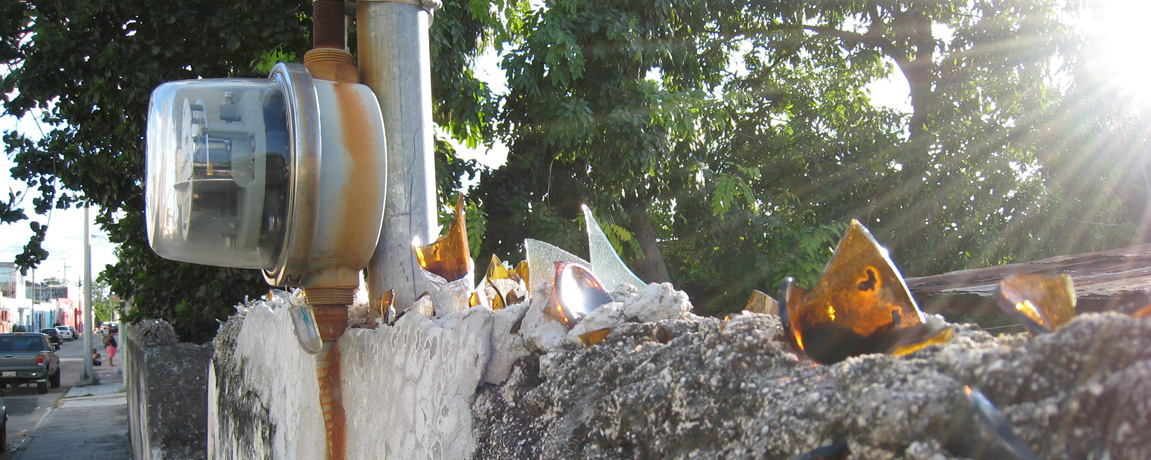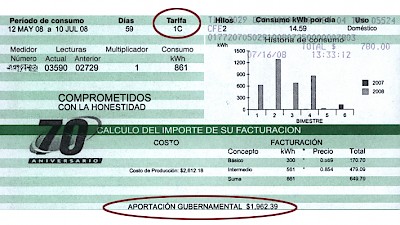Saving Energy in the Yucatan
If you live here, you know about the CFE: La Comisión Federal de Electricidad. But no one calls it CFE here in Mexico. They call it by its first name only: Comisión, and everyone knows who they are talking about. Electricity is the most expensive utility in Mexico, at least among the expat crowd. Comisión has a great website, where they proudly proclaim, in both English and Spanish, that they are una empresa de clase mundial (A world class company). On the website, you can learn about their mission, find out the weather all over Mexico, read the history of the Comisión (did you know that as late as 1937, there were three different companies providing power in Mexico?), read their financial statements, and of course, pay your bill. Oh, oops! You can't pay your bill there... but they will refer you to a bank (Banamex, Banorte, Inbursa, Bancomer, HSBC or Santander) where you CAN pay your bill online. Of course, there is much MORE information on the Spanish side of the website, but really, the fact that there is an English website at all is rather impressive.
Usually, we have no occasion to read the website. We pay our bills, in cash usually, and we are grateful for reliable electricity. But the other day, due to personal circumstances, we learned something about electricity consumption here in Mexico, and we thought we'd pass it on. This is not something we would have ever known if we hadn't moved from one house to another and noticed a big change in our electric bill.
In our old office, we worked in a traditional colonial home that had been renovated. Due to a lack of windows, we ran two mini-split air conditioners all day, every day while we were working. We had a small refrigerator. We regularly paid bi-monthly bills of $8,000 pesos or more during the summer months. We figured this was just the cost of doing business.
Flash forward to our new home and office combined. We built this building with air flow in mind. We built higher ceilings, a second story, skylights that open, and a breezeway, so consequently, we have less need for air conditioning, even during the hottest summer days. In addition, this house and office are almost completely new: new walls, new wiring, new fixtures. Electricity flows unimpeded by faulty connections or old wiring. Our appliances are all new, so we have energy-efficient air conditioners and refrigerators (yes, we have two refrigerators). The house and office combined are at least three times larger than the former house and office, and yet the CFE bills have been less than a third of our former bills.
(Insert mental picture of us quizzically scratching our heads...)
We were extremely grateful for this... but also puzzled. We looked at the meter... yep, the right meter number is on our bill. The meter is turning. The reading on the bill is correct. We were a little afraid to ask, but we called CFE to understand why our new bills are so much lower. Here is what we learned:
If a house uses over 850 kilowatt hours (kWh) of electricity per month, averaged over a year, it will get bumped from the "1C" Tarifa (rate) to the "DAC" Tarifa (De Alto Consumo, which means "of high consumption"). Once this happens, your rate climbs in three ways. First, DAC customers are charged a minimum of $65 pesos per month. Secondly, the Basico (basic) charge for DAC consumers increases from about $0.5 to $2.5 pesos per kilowatt hour (summer prices). The third whammy (that's the technical term in English for golpe) is that the government does not give you an Aportación Gubernamental (Government Subsidy). That aportación can underwrite more than two thirds of your bill every month, which is certainly not trivial. Take a look at our last bill, below, for reference.
If you find yourself still categorized 1C, know that you have to stay under 850 kilowatt hours of average energy consumption per month every year. You'll enjoy lower energy prices and a government subsidy if you do. If you use more than that for twelve months running, then be prepared for much higher energy bills and no subsidy. If you find yourself already in the DAC category, what can you do? Cut your energy costs down to under 850 kilowatts per month for 12 months, and the CFE computers will (supposedly) lower your rates automatically. If they don't, here's what you can do: Take another look at the copy of the bill below. See the column titled, Consumo kWh por dia? Multiply that number by 365 and divide by 12. That's your average monthly consumption. If the number is less than 850, chances are you qualify, so take a stroll down to La Comisión and ask them to change your Tarifa back to 1C.
If these policies aren't motivation for cutting energy consumption, we don't know what is.
ADDENDUM:
In investigating this issue, we have learned more about how CFE charges.
CFE rates each city in Mexico according to its average temperature. Merida is a "1C" city, whereas Chelem, por ejemplo (for example) is a 1B city, meaning it's average temperature is lower (in this case) and warrants less energy usage. The chart below shows the level of Kilowatts per month that the consumer must stay below in order to avoid being charged as a DAC (de alto consumo) customer.
1 up to 250 Kwh/month
1A up to 300 Kwh/month
1B up to 400
1C up to 850
1D up to 1000
1E up to 2000
1F up to 2500
To explain, if you live in Chelem (a 1B city), then you have to keep your consumption below 400 kilowatts per month in order to keep your 1B designation (and your lower rates and your government subsidy). If you live in Merida, you get to consume up to 850 kilowatts per month before moving to the DAC designation.
Any questions?
Editor's Update: We recently followed a Google ad to this wonderful YouTube page sponsored by CFE. It's in Spanish, but even if you don't understand it all, you will certainly get that CFE and Mexico are beginning a campaign to teach Mexican children about saving energy. Viva Mexico!
Website of Comisión Federal de Electricidad











Comments
Marorie Ratcliffe 12 years ago
I am trying to find a good place inMerida to buy sofa cushions for our cement sofa. Also a double bed futon mattress. Any suggestions?
Reply
Joe froio 12 years ago
Has anyone paid their CFE bill online using their Bancomer account? I have been trying to do so with no luck. I get to a screen that asks to enter a number which should be found above the bar code on my CFE bill. I have tried all combinations of the numbers to no avail.
Any suggestions? I'd like to pay it this way because I am in the U.S. most of the year.
Thank you.
Reply
Anna Martinez 13 years ago
OK - so I know this is an old article but the CFE is still out there, still robbing its consumers and still hiding information. DID ANYBODY ever come across the map/documentation that shows where each CFE tarrif boundary is? The closest I come is the CFE page that says the tarrif is by region thus all of Campeche, Quintana Roo & Yucatan should be the same tarrif (I think 1C). The actual price of the tarrif may differ by state BUT we should all be 1C (until we hit DAC) due to the temperatura media minima (reports supposedly kept by Conagua). I live in a 1 B area and within 1 KM on all 4 sides of me it is 1C. Anybody pursue this with a civil lawyer yet?
Reply
Working Gringos 14 years ago
Brenda, its true that the kitchen can heat up the house in hot weather, but we have found that with all the open doors in our house, it doesn't much matter. We only have air conditioning in the bedrooms and offices, so the heat from the kitchen doesn't affect our power usage for AC. When it gets too hot in the kitchen or living room, we just jump in the pool!
Reply
Brenda Thornton 14 years ago
If I remember correctly, the Working Gringos used double walls when constructing their home, so it would resemble the colonial home walls in depth, and one would think that would assist in energy usage, but the newer, more energy efficient appliances and computers can make a huge difference in power usage.
I do not remember which windows were used in Working Gringos home, but we installed energy efficient windows in our home, with the heat reflection spray included on them last year, and our usage, despite record setting temperatures this summer, went down by a third, without any further significant changes.
Were we to build a new home in Mexico, I think I would also use the LED inserts in light fixtures, first to cut energy usage even further than the new, energy efficient bulbs, but because they do not have the disposal problems because of Mercury in the others, and because one may well not have to change them for ten to fifteen years. Just think about fixtures on those high ceiling and things.
Undoubtedly, the skylights which open and the breezeway create a solar chimney and greatly effects the usage, as well. The one thing we simply must have if we do relocate to Merida and build or upgrade an existing home is a small outdoor kitchen, with a sink with hot water, a stove top, a grill, and perhaps even a small oven, along with a protected small refrigerator. Moving that outside so the house is not heated up by cooking would be a tremendous way to manage to use just ceiling fans and stay comfortable and cut the need for air conditioning. We put in a two burner outdoor attachment to our grill and a portable oven on our patio and it is so nice to be able to put something on to simmer, check it periodically, or even slow bake some things in the oven, and got have to heat up the house. Clean up is a pain, as we don't have a sink, so that is simply a must do on a real usable outdoor kitchen.
Reply
Working Gringos 14 years ago
Trudy, by the way, to your question of 2009, No. We aren't aware of extra charges (other than installation and any "per account" charges) for having an extra line.
Reply
Trudy 14 years ago
Well, it looks like I didn't get an answer to my 2009 question. We are now living in our house...albeit unfinished...and we are borrowing power from our neighbor. That's with his knowledge. lol But I did ask CFE the question I posted above and the lady told me the rate does not change. The initial charge for putting in dos hilos/two lines is a bit higher, but it's nominal.
I live in Quintanna Roo, whereas Merida is in Yucatan. CFE has the same procedures in both states. The rates could be different, but it's still a matter of keeping your usage under the specified kilowatt hour.
As for a/c...I once rented a house with three a/c units. I did not use them during the day...I opened the doors. But at night for decent sleeping, I turned the a/c on for an hour or two before bedtime and closed the door. When I went to bed, I turned it off and left the door shut. It was like sleeping in a refrigerator and kept the electricity bill down. Worked for me.
Reply
Rich 14 years ago
Thanks for this very thorough explanation. Do you know if the rates have changed in 2011? We've been visiting Mexico for several months and paying electric to the landlord, but curious if he's overcharging us. He charged 5 pesos a kilowatt hour, which seemed high. Thanks!
Reply
Trudy 16 years ago
I'm wondering if the number of hilos coming into your residence makes a difference. We live in Macario Gomez and are categorized 1B. We are renting and do not have hot water, a/c or even glass in the windows. We are pretty much at the mercy of the weather.
Within a year we plan to begin building our own home on land we have recently purchased. We will be remaining in the same area. I was hoping to build a house with enough air flow and a second floor so we can live without a/c and still live more comfortably than we are currently living.
If we should opt for a/c and need a second line/hilo for 220, will this negatively impact the bill and cause our electricity costs to skyrocket, even if we don't use the a/c? Will the kwh we use be charged at a higher rate for the existence of 220?
Thanks for any help you can give. Life is good!
Reply
Brenda Thornton 16 years ago
Steve may be one to something about the solar systems, or for some a wind turbine. Panels run about $90 in the U. S. and it takes about ten for a 1Kw of power. Add in the wiring and the battery pack and then the invertor and a change for it to revert to the public system, and one should still be able to save money based on what I have read in the article. We looked into a solar unit in the Houston area, smog and all, and it would cost about 17.5 cents/ Kw compared to the 12.5 cents/ Kw we were paying for the public.
If the Kw costs can be as high as I have seen quoted, then the solar should pay for itself quickly, and most battery situations can provide enough for virtually 48 hours if one had two really overcast or cloudy sky days.
Reply
paula from toronto 16 years ago
What is the CFE rating of Progreso? 1 or 1A or 1B
Thanks for the great article. P.
Reply
« Back (10 to 21 comments)Next »